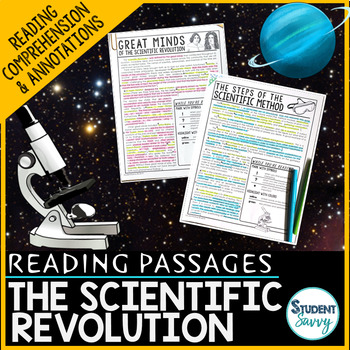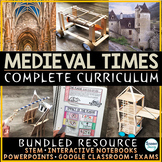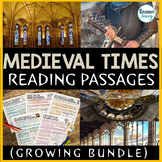The Scientific Revolution Reading Passages - Questions - Annotations
- PDF
What educators are saying
Also included in
- Enhance your Middle Ages curriculum with our Medieval Times and Early Modern Times Complete Curriculum Bundle, available in digital Google Classroom and PDF print formats. With over 1500 pages/slide of material, this comprehensive resource covers Early Byzantine, Early Islam, West Africa, MedievalPrice $190.00Original Price $314.93Save $124.93
- Medieval Times Reading Comprehension Passages, Worksheets, Questions, and Annotations Bundle! This bundle contains 11 StudentSavvy Reading Passage Resources! 1.) Early Byzantine Reading Passages 2.) Islam – Islamic World Reading Passages 3.) West Africa Reading Passages 4.) Medieval China ReadinPrice $40.99Original Price $57.75Save $16.76
- The Scientific Revolution Activities Resource Bundle! This bundled product contains the following 6 Scientific Revolution StudentSavvy resources: Interactive NotebookReading PassagesInteractive PowerPointSTEM ChallengesGoogle Classroom Student ProjectsAssessments / Exam / Test______________________Price $18.99Original Price $22.74Save $3.75
- ALL of the Reading Comprehension Passages in the StudentSavvy Store! Nonfiction **CURRENTLY 273 Passages!**-Worksheets - Reading Comprehension Passages, Questions, and Annotations--Both Print (PDF) & Digital Options (either in Google Slides or Easel by TpT) It contains Engaging, Non-Fiction ReadPrice $195.00Original Price $302.21Save $107.21
Description
The Scientific Revolution Worksheets - Reading Comprehension Passages, Questions, and Annotations
This resource is designed for a Scientific Revolution unit. It contains 5 Engaging, Non-Fiction Reading Comprehension Passages with Directions for Student Annotations! Reading Comprehension Questions also included!
Questions & Answer Keys for Each of the 5 Reading Passages!
COMMON CORE ALIGNED! Aligned with The Scientific Revolution Interactive Notebook
Quick overview of topics covered in this resource include:
1.) A New Way of Thinking: The Scientific Revolution
-“On the Revolution of the Heavenly Spheres” book by Nicolaus Copernicus changed the way people thought of the world – realized that Earth was not the center of the universe. His book may have began the Scientific Revolution.
-Overview of key ideas that came about from the Scientific Revolution (The realization that science is important, beneficial to society, and exciting. Earth revolves around the Sun, The Scientific Method, Laws of Motion, etc. )
-Classical science and the Humanist movement paves the way for Scientific Revolution
Keywords: Scientific Revolution, theory, Humanism
2.) The Great Minds of the Scientific Revolution
-Overviews of the following great thinkers:
Nicolaus Copernicus (and the heliocentric model)
Tycho Brahe (astronomer who studied the night sky and planets, observed the Super Nova of 1572)
Galileo Galilei (improvements to the telescope, theory of inertia)
Sir Isaac Newton (Newton’s Law of Motion, reflecting telescope, color - objects reflecting light)
Sir Francis Bacon (using proper scientific method – supporting theories with proof, observation, and experimentation)
Rene Descartes (“I think, therefore I am” great philosopher, made connections between geometry and algebra)
Keywords: universal gravitation, inertia, heliocentric model, geocentric theory
3.) Classical Science and Other Influences
-Preserved ideas from the Ancient Greeks influenced the ideas that came from the Scientific Revolution
-Overview of famous Greek Philosophers that came from this time period – Aristotle, Euclid, Galen, etc.
-Overview of Rationalism (another influence of the Scientific Revolution) – viewing the world in a logical, rational way. Rationalist philosophers include Rene Descartes, Baruch Spinoza, and Gottfried Wilhelm Leibniz
Keywords: Rationalism
4.) Theories, Inventions, and Discoveries of the Scientific Revolution
-Introduction to how the Scientific Revolution was a time for invention and discovery (a new way of thinking)
-Overview of Geocentric Theory and Heliocentric Model
-Overview of inventions - the microscope, barometer, thermometer, telescope (how Galileo improved the design)
Keywords: Geocentric theory, Heliocentric model, barometer,
5.) The Steps of the Scientific Method
-Overview of what the scientific method is (step-by-step set of procedures, gold standard for investigating the natural world)
-Provides each of the six steps in detail
Keyword: The Scientific Method, hypothesis
You may also enjoy:
Medieval Times (Entire) Curriculum
Ancient Civilizations (Entire) Curriculum
Early Middle Ages - Medieval Europe Interactive Notebook
Early Middle Ages - Feudalism Medieval Europe STEM
Medieval China Interactive Notebook
Medieval Japan Interactive Notebook
West Africa Interactive Notebook
West Africa Interactive PowerPoint
Medieval Times Interactive Notebook Bundle
Medieval Times STEM Challenges
Byzantine Empire STEM Challenges
Byzantine Empire Interactive Notebook
__________________________________________________________________
Tips for Savvy TpT Shoppers:
How to receive credit on TpT to use for future purchases:
• Go to your My Purchases page. Under each purchase you'll see a Provide Feedback button. Simply click it and you will be taken to a page where you can give a quick rating and leave a short comment for the product. I value your feedback greatly as it helps me determine which products are most valuable for your classroom so I can create more for you.
Be the first to know about my new discounts, FREEBIES, and products:
• Look for a green star near the top of any page within my store and click it to become a follower. You will now be able to see FREEBIES and customized emails from my store!
©2019StudentSavvy
All rights reserved by author. Permission to copy for single classroom use only. Electronic distribution limited to single classroom use only. (unless you purchase the multiple license)
____________________________________________________________









